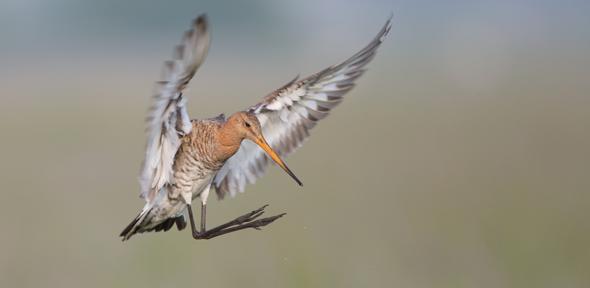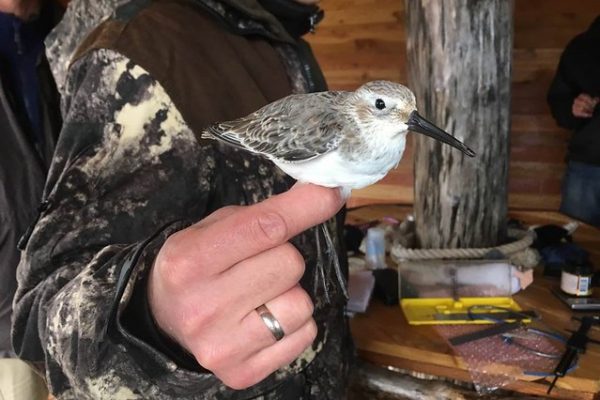-
Interview with a Winner of 2017 Knots Drawing Competition: A Young Birder in the Making
Shinhye Han EAAFP Secretariat, Intern Jeongsu Yuk, a winner of 2017 Knots Drawing Competition, visited the EAAFP Secretariat office on the 28th of December, 2017. He received a KOWA TSN660 series field scope for the Flyway Prize. He looked so happy to have received the prize, and also have finished Korean College Scholastic Ability Test last […]
Continue reading -
Population Decline of Migratory Waterbirds and Habitat Changes – Shorebirds as Indicators: A side event at the AWS 2017
EAAFP Secretariat The Asian Wetland Symposium 2017 was held in Saga, Japan from 7 to 10 November 2017 and brought together 450 participants from 26 countries. EAAFP Communication Officer Tomoko Ichikawa gave a presentation on the implementation of World Migratory Bird Day in the East Asian-Australasian Flyway in the Session 8 on CEPA and co-chaired […]
Continue reading -
저어새, 너는 누구냐?
권전오, 인천발전연구원 연구위원 1987년 겨울, 홍콩에서 288마리가 확인된 저어새는 언제 멸종될지 모르는 위기에 처해있었다. 1996년, 남북한, 중국, 타이완, 홍콩, 베트남, 일본 등에서 온 조류 전문가들이 베이징에 모여 저어새 보전을 위한 국제워크숍을 개최했고 2년 후엔 위성 추적장치를 단 저어새가 강화도 북단 무인도에서 번식한다는 것을 확인할 수 있었다. 2000년 7월, 강화남단갯벌과 저어새 번식지는 천연기념물 419호로 지정됐고 이후 […]
Continue reading -
不安定な政治情勢が種の損失をもたらす
Read in English 2017年12月20日 ケンブリッジ大学(訳:天野達也博士) 世界の生物多様性について大規模な解析を行った研究により、人類の環境に対する影響を示す他のどの指標よりも、各国におけるガバナンスの有効性の低さが種の減少を最もよく説明することが示された。社会・政治情勢が不安定である国では、保護区の効果も望めないことが示されている。 過去30年に及ぶ世界の生物種の変化を調べた大規模な研究によって、経済成長や気候変動、人口増加など様々な要因の中で、各国におけるガバナンスの有効性の低さが種の減少を最もよく説明する要因だということが示された。 Nature誌に発表されたこの研究では、保護区は生物多様性の保全に有効であるものの、その効果は社会・政治情勢が安定している国でのみ得られるということも示されている。 この研究では、水鳥類の生息地である湿地生態系が地球上で最も豊かな生物多様性を維持している一方、現在最も脅威にさらされているという点に注目し、1990年からの水鳥種の動態を生物多様性全般の変化を表す指標として用いた。 ケンブリッジ大学が主導した国際チームによるこの研究では、全世界における2万6千の調査地で記録された461種の水鳥に関する240万件にも及ぶデータが解析された。 チームはこの巨大なデータを用いて、まず様々な国や地域における局所的な水鳥個体数の変化を定量化した。次にその結果と、各国における暴力発生率や法による支配、政治腐敗などガバナンスの様々な側面を指標化したWorldwide Governance Indicators(世界ガバナンス指標)、及びGDPや保全努力量などその他のデータとの比較を行った。 その結果、西・中央アジアや南アメリカ、サブサハラアフリカといった、平均的にガバナンスの有効性が低い地域で、特に水鳥の減少が著しいことが明らかになった。 一方で、大陸ヨーロッパでは減少している種も存在するものの、平均的には水鳥類は最も増加していた。 各国におけるガバナンスの有効性が生物多様性の損失を説明する最も重要な指標であるという結果は、この研究によって世界で初めて示された。 「全世界で生物多様性の保護区は拡大し続けていますが、今回の研究の結果はガバナンスの有効性が低いことでこういった保全努力の効果が失われる可能性を示しています。」と、ケンブリッジ大学の動物学部とExistential Risk研究センターにおいてこの研究を主導した天野達也博士は指摘する。 「ガバナンスと社会・政治情勢の安定は、今後環境政策や保全を発展させていく上で極めて重要な要素のひとつであると言えるでしょう。」 この研究で天野氏は、英国のケンブリッジ大学とバス大学、米国のサンタクララ大学に所属する研究者、そして国際湿地連合及び全米オーデュボン協会と共同研究を行った。 論文の著者らは、自然界の変化を表す世界規模のデータが不足していることで、「生物多様性の危機」についての理解が十分に進んでいないと指摘する。しかしながら、生物多様性変化のパターンを理解するうえで、水鳥類に注目することには利点があると言う。 水鳥にはカモ類やサギ類、フラミンゴからペリカンまで多様な種が存在している。これらの種が生息している湿地は、淡水域から高地まで地球上の13億ヘクタールもの面積を占め、極めて重要な生態系サービスを提供している。また、湿地は人類の活動によって最も改変されている生態系のひとつであることが知られている。 さらに、水鳥類のモニタリングには長い歴史がある。湿地保全連合によって毎年行われている全世界調査には、過去50年に渡って1万5千人以上ものボランティアが参加してきた。全米オーデュボン協会によって毎年行われているクリスマス・バード・カウントは、1900年から続けられている。 「この研究は、生物多様性の損失を食い止めるために我々が何をすればいいのかについて、水鳥類のモニタリングが貴重な知見を提供し得ることを示しています。」と、湿地保全連合におけるアフリカ-ユーラシア水鳥センサスのコーディネーターである共著者のSzabolcs Nagy氏は言う。 この研究で検証された人間活動の影響を示す他のどの指標よりも、国のガバナンスの程度は重要な役割を果たしていた。「ガバナンスの有効性の低さは、しばしば環境保全に関する法が適切に執行されないことや環境保全に対する投資の欠如と関係があり、結果として生息地の損失につながります」と天野氏は言う。 またこの研究では、GDP成長率と生物多様性の関係についても明らかにしている。すなわち、GDP成長率が高い地域ほど、水鳥種は減少していた。 水鳥類は平均でみると南アメリカで最も減少しており、減少率は毎年0.95%、過去25年では平均21%の減少が見られた。また天野氏は、水鳥類が西・中央アジアの内陸部で著しく減少していたことに驚いたと言う。 イランやアルゼンチンなどアジアや南アメリカの一部地域において、水資源の不適切な管理やダムの建築が原因となり、保護区に設定されていても干上がってしまう湿地があることを、著者らは指摘している。 ガバナンスが有効でない場合に種が失われるもう一つの原因として、狩猟規制の影響も重要だと考えられる。「政治情勢が不安定なことで法律も適切に執行されなくなり、結果としてたとえ保護区の中であっても持続可能でない、しばしば違法の狩猟が促進されることがあります。」と天野氏は説明する。 実際この研究では、ガバナンスが弱い国に設置された保護区は生物多様性の保全に貢献していないことが示された。 天野氏が関わった最近の別の研究では、地域住民や先住民によって主導されている草の根レベルの活動が、政府によって主導されている活動よりも効果的に生態系の保全を行える可能性が示されている。恐らくこういった市民レベルの活動は、政治情勢が不安定な地域において生物多様性の保全を行うための有効なアプローチのひとつであると言えるだろう。 Original Link https://www.cam.ac.uk/research/news/political-instability-and-weak-governance-lead-to-loss-of-species-study-finds Reference Amano, T et al. Successful conservation of global waterbird populations depends on effective governance. Nature; 20 December 2017; DOI: 10.1038/nature25139
Continue reading -
Political instability and weak governance lead to loss of species, study finds
Read in Japanese 20 December 2017 University of Cambridge Big data study of global biodiversity shows ineffective national governance is a better indicator of species decline than any other measure of “anthropogenic impact”. Even protected conservation areas make little difference in countries that struggle with socio-political stability. “We now know that governance and political stability […]
Continue reading -
Russian Far East Shorebird Workshop (9-11 October 2017)
Jonathan C Slaght, Wildlife Conservation Society Workshop Summary: Twenty-one avian specialists from Russia and the United States met from October 9-11, 2017 at the Wildlife Conservation Society’s Sikhote-Alin Research Center in Ternei, Primorskii Krai, Russia. The purpose of this meeting was to share ideas, practice advanced avian tracking and data analysis skills, and to identify […]
Continue reading -
Small grants application for Conservation of Scaly-sided Merganser in 2018
Diana V Solovyeva, Scaly-sided Merganser Task Force Coordinator Scaly-sided Merganser Task Force received financial support form Augsburg Zoo and Toledo Zoo for the projects aimed to conserve Scaly-sided Merganser in 2018. Task Force members and other groups are welcome to submit the free-form application for small grants up to 1,500 US dollars. Application submission […]
Continue reading -
Wader Conservation World Watch 4 Special newsletter
Wader Quest, a charity that aims to involve local groups and communities in Wader conservation, has recently published the special edition of its newsletter, the Wader Conservation World Watch Special. Below are relevant parts to EAAF: Roll of Honour – Those that stood up to be counted and said “We care!” (p. 4) Species (number if […]
Continue reading -
Wetlands and People Plan
Sandra Hails, CEPA Working Group Chair The Wetlands and People Plan for the Peel-Yalgorup System is Australia’s first CEPA action Plan for a Ramsar Site. Published in 2017, the plan has been developed through the collaborative work of a large group of interested people, with representatives from the local community members including the local indigenous […]
Continue reading -
Celebrating Australia’s Migratory Waterbirds and their habitats
Department of the Environment and Energy Australian Government Showcasing Australia’s Flyway Site Network The East Asian-Australasian Flyway Site Network is a voluntary, non-binding, collaborative project involving over 130 sites across 22 countries. The Flyway Site Network has been operating since 1996 under the Asia-Pacific Migratory Waterbird Conservation Strategy and is now supported by the East […]
Continue reading



